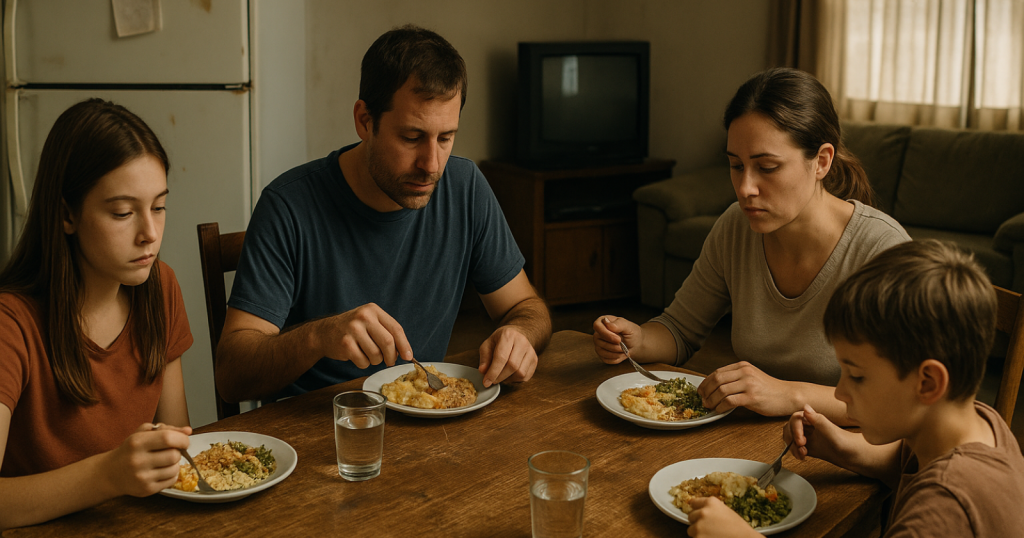There’s a certain comfort in holding onto the things that have been with us for years.
But sometimes that comfort is less about nostalgia and more about necessity.
When money is tight, replacing household items—even ones that have outlived their prime—just doesn’t make the cut.
And honestly? That says a lot about what it means to live in the lower middle class today.
The Pew Research Center found that the middle class’ share of national income has dropped dramatically over the years, sinking from 62% in 1970 to just 43% today.
No wonder so many of us are still relying on the same appliances, furniture, and gadgets that predate our kids.
Let’s dive into some of the most common ones.
1. The fridge with a hum louder than your teenager
You know that low, buzzing sound your fridge makes? The one that vibrates the kitchen floor if you listen closely? Yeah, that’s not a feature—it’s a symptom of age.
But here’s the thing: as long as it keeps the milk cold, many families don’t dare touch it. Replacing a fridge can run over a thousand dollars, and when you’re choosing between that and paying the bills, the fridge stays.
I remember visiting a friend’s house where their fridge was still plastered with magnets from the 1996 Olympics. Their son, who was born in the early 2000s, had literally never known another fridge in his life.
2. The couch that holds the imprint of everyone who ever sat on it
Old couches are like time capsules. They’ve seen birthday parties, family fights, holiday naps, and maybe even a spilled sippy cup or two.
But they’re also a dead giveaway of financial strain. When over 60% of Americans say they’re living paycheck to paycheck, it’s no surprise the sagging sofa doesn’t get replaced.
It gets covered with a blanket, propped with throw pillows, and kept until it’s practically part of the family.
And honestly? Sometimes those old couches feel more reliable than the trendy “fast furniture” you’d get today.
3. The washer and dryer that take three cycles to finish the job
Do you ever joke about your washer sounding like it’s about to launch into space? Or your dryer that leaves clothes mysteriously damp even after two full cycles?
For many families, those machines are survivors from decades past. They’re loud, inefficient, and sometimes temperamental—but they still work (sort of).
A new washer and dryer can cost well over a month’s rent. So, they stay, even if they add time, stress, and an occasional “didn’t we already wash this?” argument.
4. The microwave that looks straight out of a ‘90s sitcom
Chunky buttons. A faded green digital clock that doesn’t reset after a power outage. Maybe even a “Popcorn” button that never actually works.
That’s the microwave many of us grew up with, and for some households, it’s the same one still sitting proudly on the counter today.
Why replace something that still nukes leftovers and reheats coffee? Sure, it’s not sleek or energy efficient, but it’s dependable.
And when daily expenses are already a source of stress—as the APA notes for 72% of adults earning under $50K—a new microwave just doesn’t top the priority list.
5. The mismatched pots and pans set from your first apartment
Some of us never got around to buying that perfect cookware set. Instead, we’re still using the dented frying pan we got from Mom, paired with the wobbly-handled pot from a college roommate.
It’s not Instagram-worthy, but it does the job. And every time you scrape the bottom of that old skillet, you’re reminded of all the meals it’s helped create—stretched grocery budgets, improvised recipes, and nights where feeding the family felt like a small victory.
6. The TV that weighs as much as a small car
If you’ve ever tried to move a tube television, you know the struggle. Those things are heavy enough to make you question your life choices.
And yet, some households still have one humming along in the living room or shoved into a basement corner for “extra viewing.”
Replacing it just never seemed urgent—especially when every dollar has to stretch further than it used to.
Sometimes, I think keeping the old TV is less about money and more about mindset. It’s proof that not everything has to be replaced the second it’s out of style.
7. The dining table that’s doubled as a homework desk, craft station, and office
If you grew up with a family table that had scratches, dents, and the occasional Sharpie mark, you know what I’m talking about.
The dining table is often one of the oldest pieces in the house. It’s not just furniture—it’s a record of family life.
Maybe it was a wedding gift, or maybe it was bought secondhand decades ago. Either way, it’s lasted.
And in a way, its survival says something powerful: despite financial setbacks, despite not being able to “upgrade,” families still gather, still connect, and still build memories around it.
Final thoughts
Here’s the truth: holding onto older household items isn’t just about frugality—it’s about resilience.
Yes, it reflects financial constraints. Yes, it highlights how hard it can be to keep up in a society where the middle class is shrinking.
But it also shows resourcefulness, care, and the ability to make things last.
Maybe you’ve still got that humming fridge, the sagging sofa, or the tube TV in your basement. If so, you’re not alone.
And while it might feel like a marker of struggle, it’s also a quiet reminder of strength—the kind that stretches beyond income brackets and speaks to the heart of family life.
What’s Your Plant-Powered Archetype?
Ever wonder what your everyday habits say about your deeper purpose—and how they ripple out to impact the planet?
This 90-second quiz reveals the plant-powered role you’re here to play, and the tiny shift that makes it even more powerful.
12 fun questions. Instant results. Surprisingly accurate.

